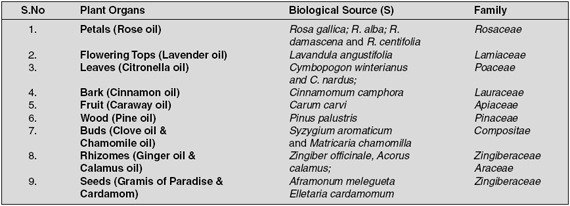2.6 Volatile Oils (or Essential Oils)
Volatile oils are the odorous and volatile products of various plant and
animal species. As they have a tendency to undergo evaporation on being exposed
to the air even at an ambient temperature, they are invariably termed as volatile
oils, essential oil or ethereal oils. They mostly contribute to the odorferous
constituents or ‘essences’ of the aromatic plants that are used
abundantly in enhancing the aroma by seasoning of eatables.
The nature has so meticulously provided specialized
secretary structures within the plants which
are primarily responsible for the generation of
volatile constitutents, as shown in the following Table 5.2.
Table 5.2 Specialized
Secretary Structures Vs Plant Sources
These volatile oils are usually formed by two modes
namely; first, by hydrolysis of some glycosides; and secondly, by
the protoplasm directly. It has been observed that the volatile oils are present
in different parts of a plant as given in Table 5.3.
Table 5.3 Plant Organs
Containing Volatile Oils
Volatile oils differ from the fixed oils in many respects
which may be enumerated below:
In general, it has been observed that a single
volatile oil invariably comprises even more than 200 different chemical
components, and mostly the trace constituents are solely responsible for attributing
its characteristic flavour and odour.
Source:Pharmacognosy And Pharmacobiotechnology By Ashutosh Kar
Source:Pharmacognosy And Pharmacobiotechnology By Ashutosh Kar





0 Comment:
Post a Comment